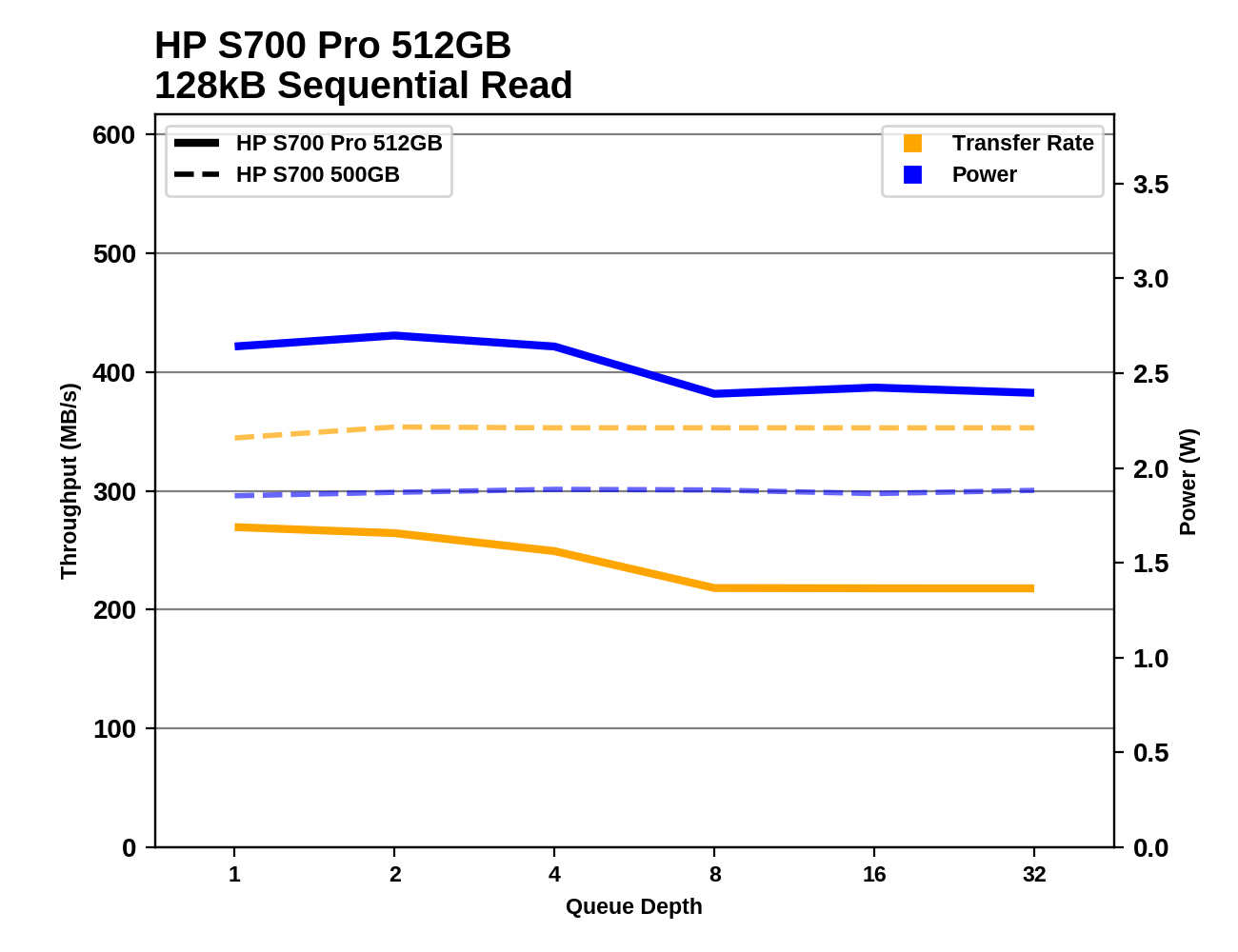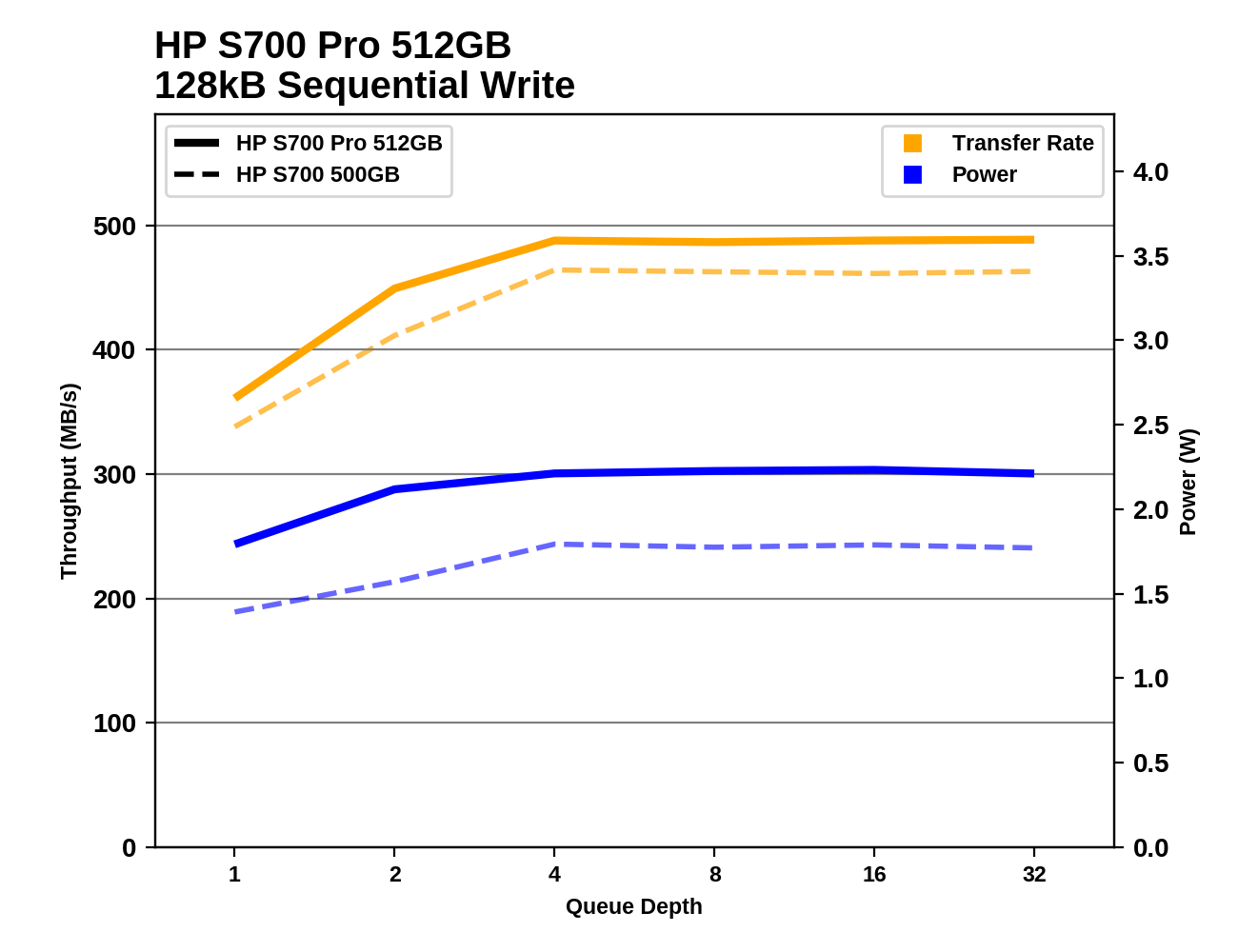The HP S700 And S700 Pro SSD Review
by Billy Tallis on September 7, 2017 9:00 AM ESTSequential Read Performance
Our first test of sequential read performance uses short bursts of 128MB, issued as 128kB operations with no queuing. The test averages performance across eight bursts for a total of 1GB of data transferred from a drive containing 16GB of data. Between each burst the drive is given enough idle time to keep the overall duty cycle at 20%.

The S700 and the larger two S700 Pros have great burst sequential read speeds, while the smallest S700 Pro has a bit of trouble (but still manages to outperform the smallest ADATA SU800 by 27%).
Our test of sustained sequential reads uses queue depths from 1 to 32, with the performance and power scores computed as the average of QD1, QD2 and QD4. Each queue depth is tested for up to one minute or 32GB transferred, from a drive containing 64GB of data.

On the longer sequential read test, the S700 doesn't drop to the bottom of the chart and instead offers above-average performance. The S700 actually has the fastest low queue depth sequential read speeds of any SATA SSD with Micron's 32L 3D NAND, including the MLC-based Crucial BX300. The S700 Pro is far slower and only its 128GB model beats the comparable ADATA SU800. We've asked HP if they can shed some light on how the S700 manages to deliver such an outstanding sequential read speed, because this is a very surprising result.

With good performance by TLC standards combined with the low power draw of a DRAMless Silicon Motion controller, the HP S700's power efficiency during sequential reads is great. The S700 Pro is near the bottom of the chart, but is a clear improvement over the ADATA SU800.
 |
|||||||||
Only a few drives have trouble delivering full performance for sequential accesses at QD1, and the HPs aren't on that list. The S700's performance is both higher and more stable across the test than the S700 Pro.
Sequential Write Performance
Our test of sequential write burst performance is structured identically to the sequential read burst performance test save for the direction of the data transfer. Each burst writes 128MB as 128kB operations issued at QD1, for a total of 1GB of data written to a drive containing 16GB of data.

The HP S700 is just a bit slower than average for burst sequential write speed, and the S700 Pro is right around the average. The Crucial MX300 and the smallest ADATA SU800 are the only real outliers on this test.
Our test of sustained sequential writes is structured identically to our sustained sequential read test, save for the direction of the data transfers. Queue depths range from 1 to 32 and each queue depth is tested for up to one minute or 32GB, followed by up to one minute of idle time for the drive to cool off and perform garbage collection. The test is confined to a 64GB span of the drive.

The longer sequential write test shows that the 120/128GB class drives are at a significant disadvantage, but the S700 Pro performs well among that cohort. The larger S700 and S700 Pro drives all offer decent sustained sequential write speeds and rank quite a bit higher than for the shorter sequential write test.

The larger two S700s join the OCZ VX500 at the top of the efficiency chart for sequential writes, and the larger S700 Pros aren't far behind. The smallest S700 Pro is far less efficient than its larger siblings, but offers 60% higher performance per watt than the ADATA SU800 and is in the top of its class (again, not counting the discontinued Samsung drives). The 120GB S700 has the lowest efficiency.
 |
|||||||||
The 500/512GB HP drives and the 250GB HP S700 don't saturate until QD4, while the 256GB S700 Pro manages to saturate at QD2. The 128GB S700 Pro runs out of spare area while the test is at QD2, so it never comes close to sustaining a speed that saturates the SATA link. The 120GB S700's performance is relatively consistent and increases somewhat with queue depth, but is overall still quite slow.










54 Comments
View All Comments
blahsaysblah - Thursday, September 7, 2017 - link
Anyone see the size of the S700 and think a new plug-in format for SSDs is in order. Been wishing for vertical M.2. ports since they launched. 2280 is definitely shorter than any standard video card and 2242 would be easy to engineer so it cant be snapped off easily/accidentally.Just a row of SATA M.2 cards lined up not too close to video card. Or, six M.2 ports to replace the SATA ports normally on a board. Wish cables would go away sooner.
romrunning - Friday, September 8, 2017 - link
Sure, look at the U.2 connector. More enterprise use right now, but it's on some consumer boards as well. It can connect PCIe NVMe drives.blahsaysblah - Friday, September 8, 2017 - link
Way too big. I dont understand why m.2 cant be made vertical, especially for a 2242 or 2230 sized card.Just plug in cards like DIMMs,...though i checked, they are only around 30-32mm high.
No more cables, just plug the storage directly into motherboard.
Space Jam - Thursday, September 7, 2017 - link
>While the HP S700 and S700 Pro are not currently priced competitively, they do show that there's value in continued firmware tuning. More than a year after Micron's 32-layer 3D NAND hit the market, the HP S700 sets a new record for sequential read performance from a four-channel controller, and helps show that DRAMless SSDs can't be immediately dismissed from consideration.With the pricing being what it is this SSD is laughable. For me this is kind of a deathnail for the idea of DRAMless SSDs as it's not cheaper, which is the whole reason for sacrificing DRAM and stomaching a substantial performance differential. And its DRAM posting Pro-variant manages to tango with the better drives...by being significantly more expensive with a meager warranty; albeit with fairly generous write endurance ratings...not that that matters with performance dropping like a rock on both S700 and S700 Pro as it reaches full.
The best I can say about the drive is that it isn't a HDD.
RaistlinZ - Thursday, September 7, 2017 - link
Sorry Billy Tallis, but there's no reason to buy either of these SSD's. They cost MORE and perform WORSE than drives that have been out for a few years now.StrangerGuy - Friday, September 8, 2017 - link
If could be that the only purpose of your massive failure of your product is to serve as a warning to others.lilmoe - Friday, September 8, 2017 - link
This is where i would normally complain that this is worthless and meaningless in the presence of the 850 evo. But this coming from hp might serve as a warning for ssd oems TO DROP THE DAMN PROCESS. I seriously hope that's the case, and i seriously hope other pc oems follow.As bad a this ssd looks, it would be a huge upgrade for anyone buying a laptop in the $400-600 range.
lilmoe - Friday, September 8, 2017 - link
*PRICESSanX - Friday, September 8, 2017 - link
Only high tech resellers salespeople here? In two decades I've never heard a word anyone discussed the manufacturing cost of anything at politically correct Anandtech and how rigged the component pricing is. Good example: manufacturing cost of flash was $1/GB in 2009. You will see true manufacturing cost only in the peaks of recessions. And now look at current $0.5/GB. Just factor of 2 progress in 8 years?... rotflATC9001 - Friday, September 8, 2017 - link
Can't hold a candle to the 850 Evo that's...3 years old now? And is more expensive...*Yawn* next.